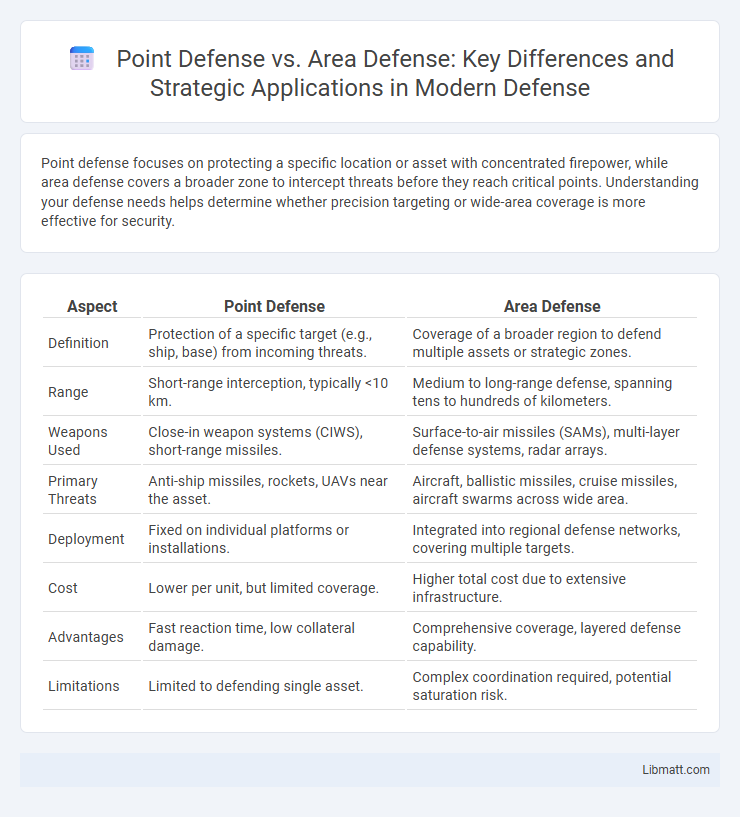Point defense focuses on protecting a specific location or asset with concentrated firepower, while area defense covers a broader zone to intercept threats before they reach critical points. Understanding your defense needs helps determine whether precision targeting or wide-area coverage is more effective for security.
Table of Comparison
| Aspect | Point Defense | Area Defense |
|---|---|---|
| Definition | Protection of a specific target (e.g., ship, base) from incoming threats. | Coverage of a broader region to defend multiple assets or strategic zones. |
| Range | Short-range interception, typically <10 km. | Medium to long-range defense, spanning tens to hundreds of kilometers. |
| Weapons Used | Close-in weapon systems (CIWS), short-range missiles. | Surface-to-air missiles (SAMs), multi-layer defense systems, radar arrays. |
| Primary Threats | Anti-ship missiles, rockets, UAVs near the asset. | Aircraft, ballistic missiles, cruise missiles, aircraft swarms across wide area. |
| Deployment | Fixed on individual platforms or installations. | Integrated into regional defense networks, covering multiple targets. |
| Cost | Lower per unit, but limited coverage. | Higher total cost due to extensive infrastructure. |
| Advantages | Fast reaction time, low collateral damage. | Comprehensive coverage, layered defense capability. |
| Limitations | Limited to defending single asset. | Complex coordination required, potential saturation risk. |
Introduction to Point Defense and Area Defense
Point defense systems are designed to protect a specific asset or location by intercepting incoming threats at close range using precise, high-rate-of-fire weapons or missile systems. Area defense covers a broader zone, integrating multiple sensors and interceptors to create a protective shield against diverse threats over a wide perimeter. These strategies balance coverage and engagement range, with point defense prioritizing swift, localized response and area defense emphasizing layered protection across larger operational environments.
Core Principles of Defense Strategies
Point defense centers on protecting a specific asset or location using concentrated firepower and short-range systems designed to neutralize threats at close proximity. Area defense employs integrated, long-range sensors and weapons to establish a protective perimeter that intercepts threats before they reach critical targets. Your choice between point and area defense hinges on strategic priorities such as coverage scope, threat types, and resource allocation.
Defining Point Defense Systems
Point defense systems are designed to protect a specific asset or location from incoming threats such as missiles, aircraft, or projectiles by intercepting them at close range. These systems use rapid-fire guns, short-range missiles, and advanced radar to detect and neutralize threats precisely where they pose immediate danger. Your choice of point defense is critical when securing high-value targets that require concentrated and immediate protection within a limited radius.
Overview of Area Defense Systems
Area defense systems protect extensive zones by detecting and neutralizing multiple airborne threats simultaneously, using integrated radar and missile networks. These systems are designed to safeguard critical infrastructure, military bases, or urban areas by creating layered defense meshes that engage targets at varied ranges. Your strategic advantage lies in the system's ability to provide broad coverage, reducing vulnerabilities and enhancing response times against saturation attacks.
Key Differences Between Point and Area Defense
Point defense targets specific threats within a limited radius, using concentrated firepower to protect high-value assets like ships or military bases. Area defense covers broader regions by integrating multiple weapons systems and sensors to intercept incoming threats before they reach critical zones. The primary difference lies in the scale and scope, where point defense emphasizes localized protection and area defense prioritizes layered, extensive coverage.
Operational Scenarios: When to Use Point vs Area Defense
Point defense is ideal for protecting high-value, localized assets such as military bases, command centers, or critical infrastructure from targeted attacks or missile strikes. Area defense covers broader regions, making it suitable for securing large geographic zones like cities, airspace sectors, or entire naval fleets against multiple, simultaneous threats. Your choice depends on whether safeguarding specific points or defending wide perimeters aligns with the operational mission and threat environment.
Technological Components in Both Defense Types
Point defense systems utilize rapid-fire weapons like Close-In Weapon Systems (CIWS) and short-range missiles, supported by radar and infrared tracking for immediate threat interception. Area defense incorporates long-range missile interceptors, advanced phased-array radars, and networked command and control systems to monitor and engage multiple targets over a broader perimeter. Both defense types rely on sensor fusion technology and automated targeting algorithms to enhance accuracy and response time.
Advantages and Limitations of Point Defense
Point defense systems provide highly localized protection by targeting immediate threats near a specific asset, ensuring rapid response and minimizing collateral damage. Their advantages include precise interception capabilities and lower operational costs compared to broader defenses but are limited by shorter engagement ranges and vulnerability to saturation attacks. Reliance on advanced sensors and quick reaction times is critical, but point defense cannot protect multiple targets simultaneously or cover large areas effectively.
Benefits and Challenges of Area Defense
Area defense provides the advantage of protecting vast zones from aerial and missile threats by deploying a network of sensors and interceptors, ensuring comprehensive coverage and reducing vulnerability to saturation attacks. It enhances force survivability and operational flexibility by overlapping defense layers, but requires significant logistical support, advanced coordination systems, and high costs to maintain effective detection and engagement capabilities. Challenges include managing complex command and control to avoid gaps in coverage and the risk of resource depletion during prolonged engagements.
Future Trends in Military Defense Solutions
Future trends in military defense solutions emphasize integrating AI-powered systems for enhanced detection and response in both point defense and area defense strategies. Autonomous drones and directed energy weapons are increasingly deployed to bolster point defense by targeting threats with precision, while network-centric warfare enables area defense to coordinate multi-layered protection across extensive territories. Advancements in sensor fusion and cyber defense further strengthen these solutions by improving threat identification and enabling real-time adaptive countermeasures.
point defense vs area defense Infographic

 libmatt.com
libmatt.com